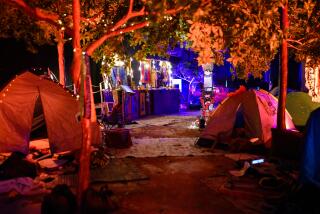‘Fight’ Uncoverrs the Power of the Berlin Wall
- Share via
“No one intends to build a wall.”
So said General Secretary Walter Ulbricht on June 15, 1961, when a German journalist asked him what he would do to stop the flood of German refugees from East to West. Less than two months later, the Berlin Wall was erected, beginning 28 years of separation and heartbreak that continued until its dismantling in November, 1989.
A traveling exhibition, which was scheduled to open Friday night at the Wilshire Courtyard complex, attempts to bring understanding of the wall, as well as the effects it had on those bound by it.
Called “Breakthrough: The Fight for Freedom at the Berlin Wall,” the exhibition was mounted by Berlin’s Deutsches Historisches Museum and Checkpoint Charlie Museum in cooperation with the Washington-based Meridian International Center. It features 96 photographs from the Berlin museums’ archives, as well as vehicles once used in escape attempts, along with explanatory text and maps.
As a special component to the Los Angeles showing, which is sponsored by the L.A. Cultural Affairs Department, L.A.-Berlin Sister Cities Committee and the German Cultural Center/Goethe-Institut Los Angeles, a 12-by-4-foot section of the wall is also on view. During ceremonies scheduled Friday night, Berlin Mayor Eberhard Diepgen was to present the 2 1/2-ton section as a gift to the City of Los Angeles, which plans to find a permanent home for it in the Civic Center.
“The first and most important thing about this exhibition is just (recognizing the importance of) the wall itself,” said Rodney Punt, an assistant general manager who directs international programs for the city’s Cultural Affairs Department. “But secondly, we’re a sister city with Berlin . . . and there are many social issues we share in common, many kinds of separations that we both face, which this can help us to realize.”
While agreeing with Punt that the exhibition will help bring understanding in Los Angeles, Margit Kleinman, Los Angeles program coordinator for the Goethe-Institut, noted that the show’s timing may prompt mixed emotions in Los Angeles’ German community.
“One cannot imagine what it was like to be there when the wall was there--the atmosphere was totally haunting,” said Kleinman, who grew up in the Stuttgart area. “So if I remember those times and see the piece of the wall here, then I am happy as a German. But I have to say that the celebration is softened by the latest news (of citizen unrest) from Germany. It’s sad for us that three years later, we look at it with less enthusiasm--there was more in store than we realized. We never thought the wall would fall, but we also never thought that when it did, we would have such joy--and such great sorrow.”
It’s not only the photographs or the section of wall that make up the show’s highlights. The panels of text also tell touching stories of lives disrupted by the separation, as well as the objects used by East Germans trying to find a way to the Western world.
Featured is a tiny BMW Isetta that was altered to fit a person around the engine in the car’s rear. According to the text, it was used successfully by six escapees before an older woman’s movements rocked the car and gave the hiding space away to nearby guards. Also on view is a wooden cart used in 1964 by 57 escapees who fled through a 160-yard tunnel dug from an outhouse on the wall’s Western side, as well as photographs of the cart in use and a map of the escape route.
Especially interesting is the “Electric Eel,” an 8 1/2-foot-long “minisubmarine” built by an engineer in 1981 as a means of escape, but never used because his own relatives turned him in to authorities.
“It’s scary--1981 wasn’t so long ago,” noted Punt during a tour of the show. “Normally, we only deal with stories of the wall (from) an art base--in movies and Kafka and so forth. We can’t really imagine it. What this does is really bring home a reality base.”
In addition to “Breakthrough,” which was mounted in an exhibition space donated as part of the city’s “percent for art” program, the nearby German Cultural Center/Goethe-Institut (Wilshire Courtyard, East Building, Suite 111) has mounted the companion exhibition, “Art on the Berlin Wall,” featuring photographs by Heinz D. Kuzdas of art created on the west side of the wall by tourists and graffiti artists, as well as by such recognized names as Keith Haring and Jonathan Borofsky.
At Wilshire Courtyard, West Building, 5750 Wilshire Blvd., Suite 111, through Dec. 11. Closed Saturdays and Sundays.
More to Read
The biggest entertainment stories
Get our big stories about Hollywood, film, television, music, arts, culture and more right in your inbox as soon as they publish.
You may occasionally receive promotional content from the Los Angeles Times.










